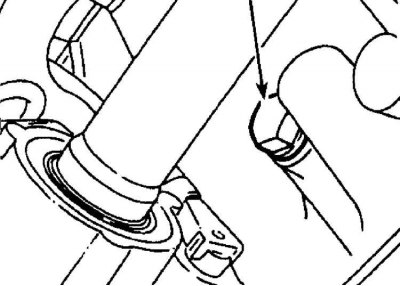Radiator drain pipe

The radiator drain pipe is indicated by an arrow.
Draining the cooling system
Attention! Drain the coolant only when the engine is cold. Coolant is highly toxic.
1. Remove the filler cap of the expansion tank by turning it clockwise until it first locks. Wait until the pressure in the system decreases, then press the cover down and turn it counterclockwise until it locks a second time, then remove it.
2. Install a suitable container under the left side of the radiator.
3. Unscrew the drain plug and drain the coolant.
 |  |
4. To completely and quickly drain the liquid from the cooling system, unscrew the air inlet screws. On all engines except 1.4L, air intake screws (indicated by arrows in the figure on the left) located in the shell and casing of the thermostat. On 1.4 liter engines, air intake screws (the screw is indicated by the arrow in the figure on the right) located in the thermostat housing and in the coolant supply hose to the cylinder head.
5. Additionally, the 2.0L XU10J4 engines have an air intake screw located in the coolant supply hose at the rear of the cylinder head.

6. All models also have a screw (indicated by an arrow) air inlet located in the upper left corner of the radiator.
7. Re-place the container under the drain plug of the cylinder block, unscrew the plug and drain the fluid from the cylinder block.
 |  |
8. On 1.4L engines, the drain plug is located on the left front of the cylinder block (indicated by the arrow in the figure on the left). On 2.0L engines, the drain plug is located at the left rear of the cylinder block (indicated by the arrow in the figure on the right).
9. After draining is completed, flush the cooling system by directing a stream of clean water through the radiator and continue flushing until clean water begins to emerge from the outlet of the lower radiator tank.
Filling the cooling system
1. Before filling the cooling system, make sure that all hoses and clamps are in good condition. Note that the antifreeze mixture must be used all year round to prevent corrosion. Also check that the radiator cap and cylinder block drain plugs are in place.
2. Remove the plug from the expansion tank.
3. Unscrew the air supply screws to the cooling system.

4. Install an additional tank (indicated by an arrow) on the expansion tank and slowly fill the system. The additional tank must be installed on the expansion tank hermetically, which will ensure that the highest points of the cooling system are filled. As the cooling system is filled with liquid, as soon as a refrigerant free of air bubbles appears from under the air supply screw, gradually, starting from the bottom screws, tighten the screws.
5. The additional reservoir must be full during the entire process of filling the system.
6. After filling the cooling system, tighten all screws and install the plug on the expansion tank.
7. Start the engine and warm it up to operating temperature, then check the coolant level and, if necessary, bring it to normal.
